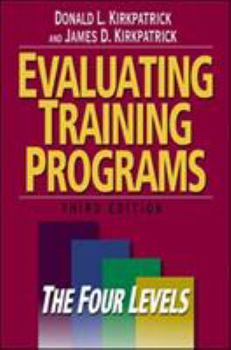Evaluating Training Programs: The Four Levels
Select Format
Select Condition 
Book Overview
An updated edition of the bestselling classic Donald Kirkpatrick is a true legend in the training field- he is a past president of ASTD, a member of Training magazine's "HRD Hall of Fame," and the recipient of the 2003 "Lifetime Achievement Award in Workplace Learning and Performance" from ASTD In 1959 Donald Kirkpatrick developed a four-level model for evaluating training programs. Since then, the "Kirkpatrick Model" has become the most widely used...
Format:Hardcover
Language:English
ISBN:1576753484
ISBN13:9781576753484
Release Date:January 2006
Publisher:Berrett-Koehler Publishers
Length:392 Pages
Weight:1.68 lbs.
Dimensions:1.3" x 6.3" x 9.5"
Customer Reviews
5 ratings
Important Reference Material For Training Careers
Published by Thriftbooks.com User , 21 years ago
I will get right to the point about this book. If you are in human resources and in charge of a training program, a Training Manager, or a Trainer, this is your training bible. If you want to move up in your company or are considering interviewing with other companies in this field, the things in this book will be part of the conversation, and if you dont know the key elements you will not be getting the job.An excellent book that will educated you about training and all the peripheral details that may be just as important as the actual class you teach.
A Significant Classic
Published by Thriftbooks.com User , 24 years ago
If you expect to interact with those in the training industry, you had best be armed with knowledge of Kirkpatrick's four-level model. For instance, if someone asks, "What are you doing about Level IV?" you need to come back with a robust response such as, "Well, we evaluate the impact of training by....". Kirkpatrick first presented his model in 1959 in a series of articles in the Training and Development Journal. In this book, the Godfather of training evaluation succinctly outlines his four-level model of training measurement: measuring reaction, measuring learning, measuring behavior, and measuring results. This book is an up-to-date enhancement of his model. It consists of corporate examples, which are always helpful, and survey templates. If you are looking for a model to increase training effectiveness, reduce cycle time of design and development of courses, or establish baselines, this is a good primer. I praise him for consistently encouraging formative evaluation. Less seasoned training professionals only conduct summative evaluation (Level 1-smiley sheets), but evaluation should not be seen as an event as much as a life-cycle process. The ISD process includes a formative evaluation approach, which is often over looked. If you read this book and measure all four levels, you will be on the right track to evaluation utopia.If you are a serious evaluator or interested in calculating return on investment, a "must read" is Jack Phillips Return on Investment in Training and Performance Improvement Programs. Phillips expands Kirkpatrick's models to a fifth level, which is return on investment (ROI), and encourages ROI at Kirkpatrick's four levels, too. If you are interested in implementing Kirkpatrick's four-level model and/or ROI, you need to read Another Look at Evaluation Training Programs. This book is a series of "best practice" articles compiled by Kirkpatrick. One final note: Keep in mind that Kirkpatrick's model is not the only one out there. For instance, there is: Kaufman's Five Levels of Evaluation, The CIRO (context, input, reaction, and outcome) Approach, Stufflebeams's CIPP (context, input, process, and product) Model, Alkins' UCLA Model, and The Phillips Five-Level ROI Framework. Choose a best-fit model that is based on your known organizational barriers and the decisions important to your stakeholders.
Kirkpatrick's Four Levels get Five Stars
Published by Thriftbooks.com User , 24 years ago
An indispensable work for anyone concerned with getting the most value from their training programs. What you'll find in this book:* A concise but solid explanation of the four levels and the purpose of each level. * Guidelines for measuring at each level.* More than a dozen case studies that demonstrate how a variety of training organizations have implemented one or more of Kirkpatrick's levels, including sample forms and data analysis. Kirkpatrick doesn't offer an "evaluation formula" with instructions to plug in an organization's name or training titles to a prefabricated shell. Instead, he presents a skeletal structure which an organization can flesh out to create an evaluation system.
Useful and informative.
Published by Thriftbooks.com User , 25 years ago
Offers a how-to approach to evaluating training programs assessing student satisfaction, mastery of content, application of learned skills, and impact on the client's business. Includes detailed techniques and formulas for measuring success with specific illustrations. Useful and informative.
An excellent introduction to the evaluation of training.
Published by Thriftbooks.com User , 26 years ago
This is an excellent book for anyone charged with evaluating training. After a relatively brief and very readable introduction to the four levels of training evaluation, the detailed case studies will provide any training evaluator with ideas they can use in their own programmes. The book is worth it for the sample questionnaire forms alone.





